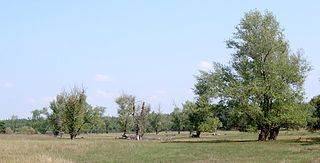
Populus section Aigeiros is a section of three species in the genus Populus, the poplars. Like some other species in the genus Populus, they are commonly known as cottonwoods. The species are native to North America, Europe, and western Asia. In the past, as many as six species were recognized, but recent trends have been to accept just three species, treating the others as subspecies of P. deltoides.

Populus nigra, the black poplar, is a species of cottonwood poplar, the type species of section Aigeiros of the genus Populus, native to Europe, southwest and central Asia, and northwest Africa.
Acinetobacter calcoaceticus is a bacterial species of the genus Acinetobacter. It is a nonmotile, gram negative coccobacillus. It grows under aerobic conditions, is catalase positive and oxidase negative. A. calcoaceticus is a part of the A. calcoaceticus-A. baumannii complex together with Acinetobacter baumannii, Acinetobacter nosocomialis, Acinetobacter pitti and Acinetobacter seifertii.

Piceid is a stilbenoid glucoside and is a major resveratrol derivative in grape juices. It can be found in the bark of Picea sitchensis. It can also be isolated from Reynoutria japonica, the Japanese knotweed.

Acinetobacter baumannii is a typically short, almost round, rod-shaped (coccobacillus) Gram-negative bacterium. It is named after the bacteriologist Paul Baumann. It can be an opportunistic pathogen in humans, affecting people with compromised immune systems, and is becoming increasingly important as a hospital-derived (nosocomial) infection. While other species of the genus Acinetobacter are often found in soil samples, it is almost exclusively isolated from hospital environments. Although occasionally it has been found in environmental soil and water samples, its natural habitat is still not known.
Brenneria is a genus of Pectobacteriaceae, containing mostly pathogens of woody plants. This genus is named after the microbiologist Don J. Brenner.

Populus fremontii, commonly known as Frémont's cottonwood, is a cottonwood native to riparian zones of the Southwestern United States and northern through central Mexico. It is one of three species in Populus sect. Aigeiros. The tree was named after 19th century American explorer and pathfinder John C. Frémont.

Aspen is a common name for certain tree species; some, but not all, are classified by botanists in the section Populus, of the Populus genus.
Acinetobacter nosocomialis is a gram-negative, strictly aerobic bacterium from the genus Acinetobacter isolated from a patient at MetroHealth in Cleveland, Ohio. Acinetobacter nosocomialis belongs to the Acinetobacter calcoaceticus-baumannii complex.
Acinetobacter guangdongensis is a gram-negative and non-motile bacterium from the genus Acinetobacter which has been isolated from a lead-zinc ore mine in Mei County in Meizhou in China.
Acinetobacter qingfengensis is a Gram-negative, rod-shaped and non-motile bacterium from the genus Acinetobacter which has been isolated from the bark of the tree Populus x euramericana.
Microbacterium populi is a Gram-positive, non-spore-formin and aerobic bacterium from the genus of Microbacterium which has been isolated from the bark Populus x euramericana.
Acinetobacter populi is a bacterium from the genus of Acinetobacter which has been isolated from a canker of the tree Populus x euramericana in Puyang in China.
Niastella is a bacterial genus from the family of Cytophagaceae.
Corticibacterium is a genus of bacteria from the family of Phyllobacteriaceae with one known species.
Corticibacterium populi is a Gram-negative, aerobic and motile bacterium from the genus of Corticibacterium which has been isolated from the bark Populus × euramericana.
Sphingobacterium populi is a Gram-negative, aerobic and non-motile bacterium from the genus of Sphingobacterium which has been isolated from the bark of the tree Populus × euramericana.
Acinetobacter larvae is a Gram-positive, aerobic, non-spore-forming, coccobacilli-shaped and non-motile bacterium from the genus of Acinetobacter which has been isolated from the gut of a larval from the insect Omphisa fuscidentalis.
Wohlfahrtiimonas populi is a Gram-negative, facultatively anaerobic and motile bacterium from the genus of Wohlfahrtiimonas which has been isolated from tree Populus × euramericana.
Streptomyces populi is an endophytic bacterium species from the genus of Streptomyces which has been isolated from the stem of the tree Populus adenopoda from the Mount Qingcheng in China.





